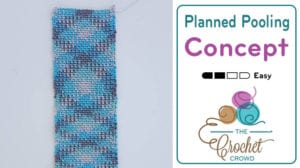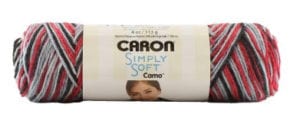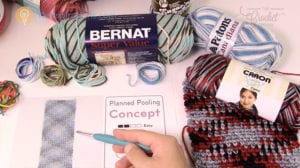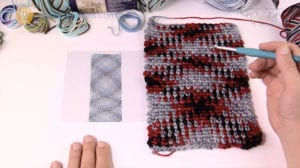
Planned Pooling with Variegated Yarn
Planned Pooling you say? What is it? Surely it isn't a group of moms bringing our kids to the local pool for a quick dip.
As a firestorm of fury in the crochet world, this concept really isn't new but the attention to it over the past few days has got people like me to wake up as the results online have been stunning. In fact, some of the examples on The Crochet Crowd have been stellar!

Pattern Suggestions
- Crochet Cool Poncho Pattern
- 5 Star Beanie Crochet Hat
- Crochet Candy Link Blanket + Tutorials
- Planned Pooling Argyle Poncho Pattern
- Corner to Corner Afghan Pattern
Resources I Looked at When Researching This:
- Repeat Crafter Me
- Twist Collective - Knitting Resource
- Crochet Spot
- All Crafts Channel
- Planned Pooling Pinterest
- Yarn Pooling Demo - Ravelry
- Google Images - Crochet Yarn Pooling
- Quick Guide to Color Pooling by Red Heart
- This Southern Girl Can - Planned Pooling
- CrochetChiq - Tutorial Video
- Glamor4You - Tutorial Video
- Crochet Jewel - Tutorial Video
- Yolanda Soto Lopez - Tutorial Video
Our Laura Jean first jumped on this a couple of weeks ago. She struggled to get a design going and it took her 9 tries. She kept changing her hook and finally got it but the hook size was smaller than recommended. For myself, I tried this 6 times and I couldn't get it to work. I used the exact same yarn and hook as Laura Jean and it just wouldn't work.
The common denominator of success is the stitch counts to start. It's certainly agreed upon the resources that the moss stitch is the way to go. Some call the same stitch by other names but it's still the same.
We realized that we have to cycle through the colour scheme and be one stitch off so that the colours can shift by one stitch in this design. Many of the resources are telling us to concentrate on the stitch counts. But in the same brand of yarn, the length of the repeat cycle of colour may be the difference and the lengths of the colours may be different. This means you cannot have the same thing across multiple brands and colour schemes.
Glamour4You YouTube Tutorial solved the issues in a simple way to adapt on the fly. It solved the issues of trying to cycle through without knowing the counts and just undoing the chain at the end of unused chains was brilliant. The technique by the host literally flipped the lid open to making this concept inclusive to all with different tensions.
For the record, I never stated I created this concept but I did research. If any credit is to be extended for the conceptual execution, it should be to Glamour4You. She is a great host and is a worthy YouTube Channel to subscribe to.
What is Planned Pooling?
This is an exciting technique to get variegated yarns to "pool" the colours so that you get a tartan or harlequin effect. It is something to experiment with. With different tensions and types of yarn, it will make a difference if it works for you.

What to Look for In A Yarn Ball
A great yarn suggestion with great colourway lengths and contrasting colours is Caron Simply Soft Camo. This is used in the tutorial example.
- Look for consistent colour changes in the ball. Stripes of colour should be about 6" to 12" in length before changing to the next colour.
- Colours that transition under 6" or the colours are slow to change from one colour to another will not work for you.
- The colours don't need to be equal in lengths for the colour transitions but keep an eye that no colour is less than 6" in length.
- The number of colours in a yarn ball doesn't matter. It's the length of the colour that is more critical.

Advice that Doesn't Work
There is advice out there to tell you how many chains to do with this concept, you need to ignore this advice. I have several reasons why:
- The person giving this advice is most likely has different tension than you. Their advice isn't wrong but you need to match their tension exactly to make it work.
- Different brands of yarn and even the same brands may have different lengths of colourways of the yarn sequence. Therefore, the chain counts cannot be consistent. For example. Bernat Super Value, the lengths of variegated colours in different colourways can be and are different. Each brand and colourway is to be treated uniquely and not the same as each other. I will show you what to look for.
- Different balls may have more or fewer colours. The chain count may not make sense for the yarn you are using.
- Changing your hook sizes using the advice of a chain count doesn't fix the issue.

Concept To Get It Right the First Time
All of the concepts will be shown in the tutorial for those who need a visual and further description of steps. If this is new for you, you will most likely notice a shift in your tension like Laura Jean's Example of the blue scarf where the crossing overlooks quicker in the beginning. It's because she relaxed and understood the concept. Chances are, you may need to try an example to become comfortable and then your 2nd version will be more consistent in colour.
Yarn Review
- Review the yarn by pulling out the yarn and looking for the sequence of variegated yarn colourway. Know where the colours begin to repeat.
- This works better if the variegated yarn has contrasting colours to make the popping of the cross overs more dominant.
- Look for the colours to be a minimum of 6" but no greater than 12".
- Use the recommended hook size on the ball band.
Begin
- Starting as close as you can to where colour is changing abruptly from one to another to create your slip knot. Note that your starting chain will not be creating any pooling at all but you need a foundation on where to start. So the chain will not match the project but it's hardly noticeable.
- Chain until the complete colour sequence is complete. This means you will stop once the colour sequence begins to repeat. It doesn't matter which colour you start with. Stop on the colour before the next colour (which is repeating) begins.
- Moss Stitch Across. SC 4th Chain from hook. *Ch 1, skip next chain, sc into next. Repeat * Across. You will not use the entire chain. You will stop when the colour sequence is completed. This will leave unused chains that you will undo later. This prevents you from having to constantly restart your chain and will get you on your way quicker.
- Before you continue, back up 1 stitch and ch-1 and pull out the stitch. This will cause the first row to be the same colour as the row below and will cause an automatic shift in the pattern. Turn.
- Each row is the same going forward. Ch 2, sc into next ch-1 space, *ch 1, 1 sc in next ch-1 space. Repeat * across. Turn.
- Repeat step 5 until your project is complete.
Jumping from One Ball to Another or Knots in Balls.
If you need to change your yarn ball if you run out of yarn or if there is a knot in the ball.
- You need to cut out the knot as the knot may not be at the right interval for colourway or the distance of the colour is compromised by the knot. Go to Step 3.
- If you need to attach another ball of yarn, you need to watch the colourway. Go to Step 3.
- When attaching the next strand, pinpoint an exact same colour transition point. For example. Say you are ending and there is a black/red switch of colour. The next ball should be at the black/red switch to begin. This will keep your sequence in line and at the same colour point. If you are not careful here, you will ruin the pooling effect of the work already done. The pooling will automatically change to something new and will look different than what you have established.
Tutorial
Crochet Pattern Ideas
[the_grid name="Beginner Crochet Projects"]
That's it for now. Have a super day!
Laura Jean
kay fulmer says
I have tried 3 hook sizes, 4 different yarns, 24 sts, 28 sts and 36 sts. No success yet. Will not go smaller than an "H" hook with worsted weight. Do not like a "G" hook with worsted, makes my hand hurt.
Brigette Fancy says
Was your yarn a worsted weight! I'm assuming it was.
Brigette Fancy says
That should have been a question, not an exclaimation...sorry!
Jeanne - The Crochet Crowd says
Yes, it is.
Terry says
Specifically what yarn did you use?
Laura Jean Bartholomew says
I used what I had on hand. I think it is RHSS Icelandic? Not 100% sure.
Terry says
thanks Laura Jeanne. I have some Caron SS, but am using it in the mermaid tail right nw, so will wait till that's done to try Have some cotton, but think the repeats are too short.